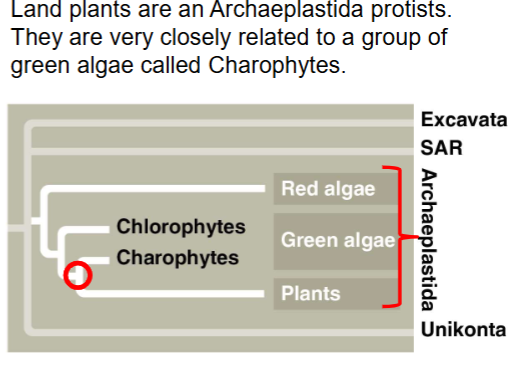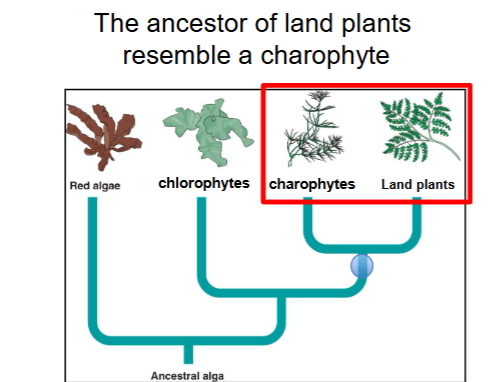BIO-Theme 9: Plant Diversity 1-How Plants Colonized Land
1/36
Earn XP
Description and Tags
Plants.
Name | Mastery | Learn | Test | Matching | Spaced |
|---|
No study sessions yet.
37 Terms
What type of protists are land plants?
An Archaeplastida protist.

The ancestor of land plants resemble a…
Charophyte.
a sister taxa of land plants

How did land plants come to be?
Land plants evolved from freshwater green algae (charophytes) during the Ordovician period (around 485–444 million years ago), transitioning from a water-dependent existence to a terrestrial one through adaptations like lignin, stomata, and a dominant sporophyte life cycle to cope with drying out, gain support, and withstand the harsh conditions of land.
All land plants have…
Heterogametes & protected embryos.
What are heterogametes?
Heterogamy is a term that refers to a wide range of phenomena in various scientific fields. “Hetero” usually refers to a difference, while “gamy” refers to reproduction.
In reproductive biology, heterogamy refers to the alternation of generations, such as parthenogenetic and sexual generations. Some aphids, for example, exhibit heterogamy.
Alternatively, heterogamy or heterogamous is sometimes used as a synonym for heterogametic, which refers to the presence of two chromosomes that are not identical in sex. The heterogamous sex, for example, consists of XY males and ZW females.
What adaptations allowed plants to live on land?
Evolved step by step.
Waxy cuticle → prevents drying out.
Rhizoids/roots → absorb water.
Vascular system → moves water & nutrients.
Seeds → nourish and protect embryos.
Diploid (2n) dominance → protects against UV mutations.
What life cycle do Chlorophyta have?
Haplodiplontic life cycle.
All land plants (closely related to chlorophyta) have a ___life cycle?
Haplodiplontic life cycle.
Relative size of sporophyte ___ as plants evolve.
Increases.
What are bryophytes (Liverworts, Mosses, Hornworts)?
Nonvascular plants — no xylem or phloem.
Live in moist environments (need water for sperm to swim).
Gametophyte (n) is the dominant, photosynthetic stage.
Sporophyte (2n) is small, short-lived, and grows on the gametophyte.
Reproduce with spores, not seeds.
Include mosses, liverworts, and hornworts.
What does nonvascular mean?
Plants without tubes (xylem or phloem) to move water or food.
What are xylem and phloem?
Tubes in vascular plants — xylem carries water, phloem carries food.
What is gametophyte mean?
The haploid stage that makes gametes (sperm and egg).
What does dominant stage mean?
The stage you see most of the time in the plant’s life cycle.
What does sporophyte (2n) mean?
The diploid stage that makes spores; in bryophytes, it grows on the gametophyte.
What are spores?
Tiny reproductive cells that can grow into new gametophytes.
What does haploid (n) mean?
Having one set of chromosomes (like sperm and eggs).
What does diploid (2n) mean?
Having two sets of chromosomes — one from each parent.
How many phyla does bryophytes have?
3 phyla, called liverworts (hepaticophyta), mosses (bryophyta), and hornworts (anthocerophyta).
Liverworts life cycle is dominated by ___.
Gametophytes.
Male gametophytes produce sperms
Female gametophytes produce eggs
How do sperms in the liverworts get to the eggs?
Sperms swim to the egg. After fertilization, the embryo on the female gametophyte will grow into a sporophyte (hang from the gametophyte).
Liverworts also have asexual reproduction using Gemma cups (grow on gametophytes)
Mosses are ___ dominant.
Gametophyte.
What does Antheridia mean?
The male reproductive structures in plants (like mosses and ferns) that produce sperm.
What does Archegonia mean?
The female reproductive structures that produce eggs and are where fertilization happens.
What are Hornworts?
Type of bryophyte (nonvascular plant).
Have long, horn-shaped sporophytes that grow from the gametophyte.
Sporophytes are large and visible compared to those of other bryophytes.
Each cell has one large chloroplast (unlike mosses or liverworts).
Found in moist habitats, often on soil or tree bark.
What is the ecological importance of bryophytes?
Act as primary producers in many ecosystems.
Spores are wind-dispersed, allowing them to spread widely.
Can survive harsh conditions like cold and drying out (desiccation).
Help in soil formation, water retention, and providing habitat for small organisms.
What are Tracheophytes?
Vascular plants with xylem and phloem for water and nutrient transport.
Have a dominant sporophyte (2n) stage in their life cycle.
Include ferns, gymnosperms, and angiosperms.
Better adapted for life on land due to vascular tissue and roots.
Why are vascular tissues important in Tracheophytes?
Provide support, allowing greater height and size.
Found in true stems, roots, and leaves (not in bryophyte rhizoids).
Only sporophytes (2n) have vascular tissues; gametophytes (n) do not.
Help transport water and nutrients throughout the plant.
What are the functions of stems, roots, and leaves in tracheophytes, and how did leaves evolve?
Stems: Support leaves and transport water/nutrients.
Roots: Anchor the plant and absorb water/nutrients.
Leaves: Increase surface area for photosynthesis.
Leaf evolution (convergent):
Lycophylls: Small leaves in club mosses.
Euphylls: Large leaves in ferns and seed plants.
Leaves of Tracheophytes evolved ____ (convergent
evolution): in Lycophytes & Euphyllophytes
Twice.
How many clades does tracheophytes have?
4 clades, they are seedless vascular plants (lycophytes & pterophytes) and seed vascular plants (gymnosperms & angiosperms.
How does the gametophyte compare to the sporophyte in vascular plants?
Gametophyte is much smaller than the sporophyte.
Seedless vascular plants: gametophytes are tiny but grow independently on or under the soil.
Seed plants: gametophytes are microscopic and depend on the sporophyte for growth.
What are Pterophytes and what is known about their relationships?
Pterophytes are ferns and their relatives (seedless vascular plants).
Phylogenetic relationships among ferns and their relatives are still being studied and clarified.
What does homosporous mean?
Homosporous describes an organism, typically a plant, that produces only one kind of spore.
Most seedless plants (clubmoss & ferns)
produce only one type of spores, thus, is
homosporous.
• The spore germinates into a gametophyte that
contains both male and female reproductive
structures
What does heterosporous mean?
Heterosporous refers to the plants producing different types of spores that are different in structure, size and function.
• All seed plants (and a few seedless vascular
plants) are heterosporous.
• They have two types of spores that give rise to
male and female gametophytes, respectively.
What are key facts about ferns?
Most abundant seedless vascular plants (~11,000 species).
Coal formed from fern forests ~300 million years ago.
Both sporophyte (large) and gametophyte (small) are photosynthetic.
What is the significance of seedless vascular plants?
Forests of lycophytes, horsetails, and ferns grew in the Devonian & Carboniferous periods.
Roots broke down rocks, releasing chemicals that reacted with CO₂ → global cooling and glaciation.
Slow decay in swamps led to peat, which over millions of years became coal.
Primitive seed plants also grew in these forests and became more prominent as swamps dried.